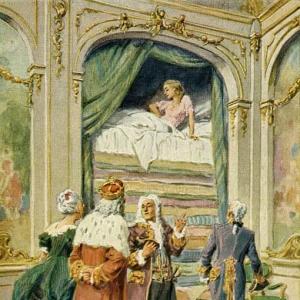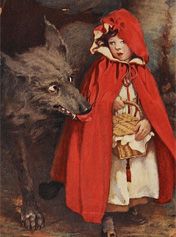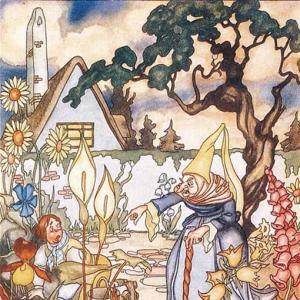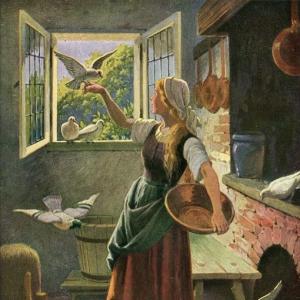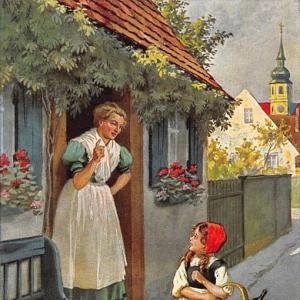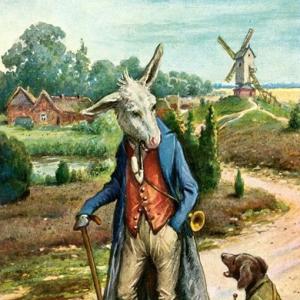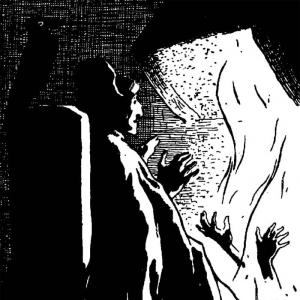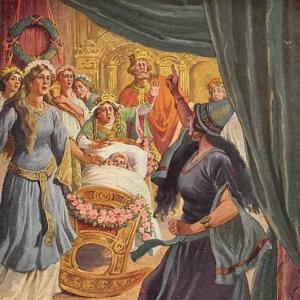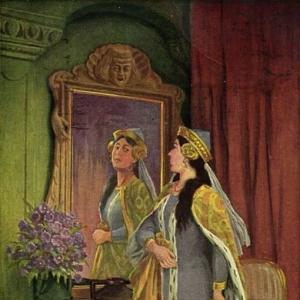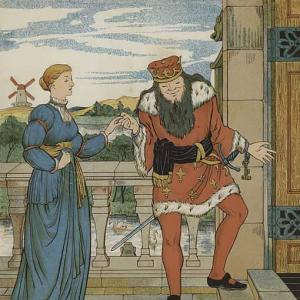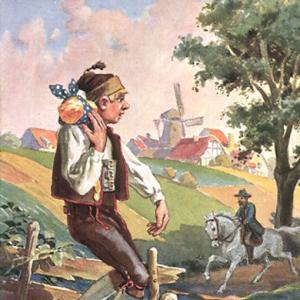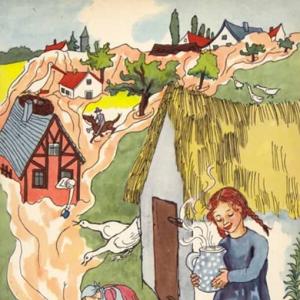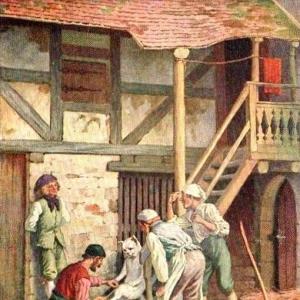Reading time for children: 4 min
There was once a prince, and he wanted a princess, but then she must be a _real_ Princess. He travelled right round the world to find one, but there was always something wrong. There were plenty of princesses, but whether they were real princesses he had great difficulty in discovering; there was always something which was not quite right about them. So at last he had to come home again, and he was very sad because he wanted a real princess so badly.
One evening there was a terrible storm; it thundered and lightened and the rain poured down in torrents; indeed it was a fearful night. In the middle of the storm somebody knocked at the town gate, and the old King himself went to open it.
It was a princess who stood outside, but she was in a terrible state from the rain and the storm. The water streamed out of her hair and her clothes; it ran in at the top of her shoes and out at the heel, but she said that she was a real princess.
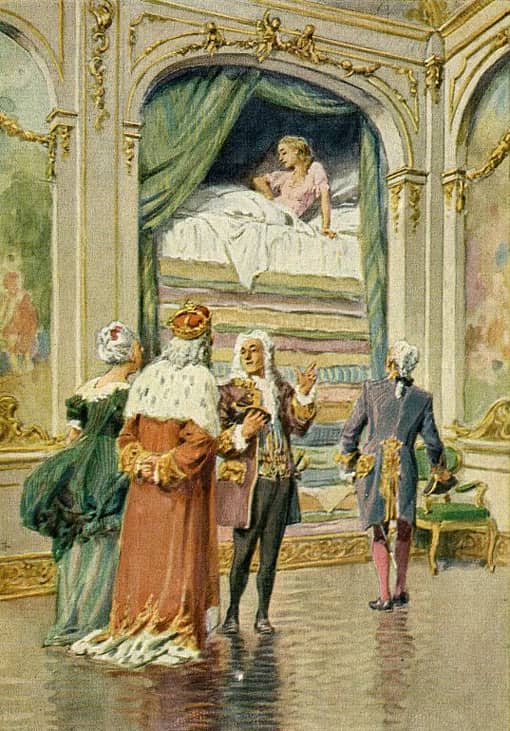 Image: Paul Hey (1867 – 1952)
Image: Paul Hey (1867 – 1952)‚Well we shall soon see if that is true,‘ thought the old Queen, but she said nothing. She went into the bedroom, took all the bedclothes off and laid a pea on the bedstead: then she took twenty mattresses and piled them on the top of the pea, and then twenty feather beds on the top of the mattresses. This was where the princess was to sleep that night. In the morning they asked her how she had slept.
‚Oh terribly badly!‘ said the princess. ‚I have hardly closed my eyes the whole night! Heaven knows what was in the bed. I seemed to be lying upon some hard thing, and my whole body is black and blue this morning. It is terrible!‘
They saw at once that she must be a real princess when she had felt the pea through twenty mattresses and twenty feather beds. Nobody but a real princess could have such a delicate skin.
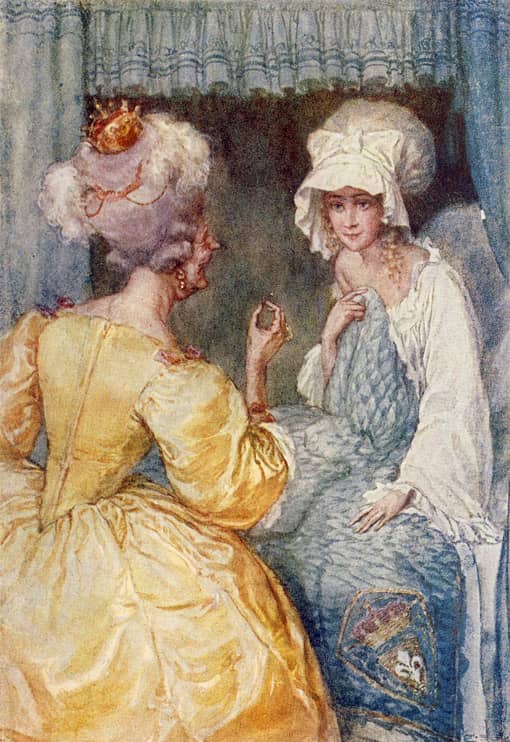
So the prince took her to be his wife, for now he was sure that he had found a real princess, and the pea was put into the Museum, where it may still be seen if no one has stolen it. Now this is a true story.
 Learn languages. Double-tap on a word.Learn languages in context with Childstories.org and Deepl.com.
Learn languages. Double-tap on a word.Learn languages in context with Childstories.org and Deepl.com.Backgrounds
Interpretations
Linguistics
„The Real Princess,“ also known as „The Princess and the Pea,“ is a fairy tale by Hans Christian Andersen. It tells the story of a prince who is on a quest to find a true princess to marry. Despite meeting many princesses, he is never sure if they are genuine. One stormy night, a princess arrives at the castle, claiming to be true royalty, but her appearance is far from regal due to the weather.
To test her claim, the old queen devises a plan: she places a pea underneath a large stack of twenty mattresses and twenty feather beds in the guestroom where the princess is to sleep. The next morning, the princess complains of a terrible night’s sleep, as if she had been lying on something hard, despite the extravagant bedding.
This sensitivity to such a small object convinces everyone that she is indeed a real princess, as only someone with exceedingly delicate skin could feel a pea through so many layers. As a result, the prince happily marries her, having finally found his true princess. The story concludes with the pea being placed in a museum, serving as a whimsical proof of the princess’s authenticity. This fairy tale humorously highlights the idea of royal delicacy and the lengths to which one might go to prove authenticity.
„The Real Princess,“ often referred to as „The Princess and the Pea,“ is a classic fairy tale by Hans Christian Andersen that has been subject to various interpretations over the years. Here are a few different interpretations that people have derived from this story:
Critique of Aristocracy and Nobility: One of the most common interpretations is that Andersen is critiquing the aristocracy and nobility’s obsession with purity and pedigree. The idea that only a „real“ princess could be so sensitive as to feel a pea through numerous mattresses suggests that the standards for what constitutes nobility are arbitrary and perhaps even absurd.
The Value of Sensitivity: The tale can be seen as celebrating sensitivity, both emotional and physical, as a rare and valuable trait. The princess’s acute sensitivity is what ultimately identifies her as genuine, suggesting that such qualities should be treasured and sought after.
Superficial Judgments: Another interpretation is that the story comments on the superficial ways people are judged. Despite the princess’s disheveled appearance due to the storm, it is the hidden test of the pea that determines her true identity. This suggests that true worth or identity is often hidden beneath surface appearances, and external appearances can be misleading.
The Role of Women in Society: The story might also be interpreted as highlighting the passive role assigned to women in fairy tales and society. The princess’s role is largely passive; she does not engage in any quest or active pursuit but is instead „tested“ and „chosen“ by the prince. This reflects traditional gender roles where women’s value is often determined by marriageability and lineage rather than personal agency.
Perfection and Realness: The tale might also explore the paradox of „perfection“ in defining a „real“ princess. The extreme sensitivity of the princess borders on impracticality, raising questions about the extent to which perfection is both desirable and achievable. It might suggest a satirical take on the lengths to which people will go to seek out an idea of perfection which might be an illusion.
Humor and Absurdity: Lastly, the fairy tale can be interpreted as a humorous and whimsical story that doesn’t necessarily hold a deep moral but is meant to entertain with its absurd premise. The exaggerated conditions of the test and the platform of multiple mattresses are inherently funny and could suggest that Andersen intended it to be more lighthearted than serious.
These interpretations show the richness of Andersen’s story and its capacity to provoke thought about social norms, human behavior, and the constructs of society.
Hans Christian Andersen’s „The Real Princess,“ often called „The Princess and the Pea,“ is a compact fairy tale that uses language to explore themes of authenticity, sensitivity, and societal definitions of nobility.
Narrative Structure: The story follows a classic fairy tale structure, with a quest, a test, and a resolution. The prince’s quest to find a „real“ princess sets the framework, the test of the pea establishes the climax, and the resolution comes with the marriage, tying the narrative to a satisfying conclusion.
Language and Tone: Andersen’s language is straightforward, using simple, declarative sentences that suit the fairy tale genre. The tone is whimsical and light, even though it deals with themes of desire, disappointment, and self-worth.
Characterization: The characters are archetypal, fulfilling roles rather than being deeply fleshed out individuals. The prince is the archetypal seeker, the old king and queen function as testers or gatekeepers of authenticity, and the princess is the ultimate prize, characterized not by her personality but by her sensitivity.
Symbolism: The pea is the central symbol, representing the delicate nature of what defines true nobility. The test of the pea is both literal and metaphorical, suggesting that true sensitivity and authenticity must be intrinsic and can withstand any barrier.
Themes
Authenticity and Sensitivity: The central theme is the definition of a „real“ princess, which is linked to the idea of true sensitivity. The princess’s ability to feel the pea signifies her genuine nobility and delicate nature.
Perception versus Reality: The story questions external perceptions and superficial judgments. What makes a „real“ princess isn’t visible; it’s an intrinsic quality felt rather than seen.
Societal Norms and Expectations: Implicitly critiques how societal norms determine identity and worth, particularly through arbitrary tests.
Moral: The tale encourages readers to look beyond surface appearances to find true worth and authenticity. It also subtly mocks the absurdity of the methods used to ascertain this value.
Cultural Reflection: The story reflects 19th-century attitudes towards class and nobility, where lineage and innate qualities were valued over actions or achievements.
Overall, Andersen uses simple yet evocative language to create a memorable tale that questions traditional notions of nobility and identity. The enduring appeal lies in its humor, economy of language, and the playful challenge to societal standards.
Information for scientific analysis
Fairy tale statistics | Value |
|---|---|
| Translations | DE, EN, DA, ES, FR, IT, NL, RO |
| Readability Index by Björnsson | 29.3 |
| Flesch-Reading-Ease Index | 84.8 |
| Flesch–Kincaid Grade-Level | 5.6 |
| Gunning Fog Index | 8 |
| Coleman–Liau Index | 7.5 |
| SMOG Index | 7.4 |
| Automated Readability Index | 5.6 |
| Character Count | 2.005 |
| Letter Count | 1.538 |
| Sentence Count | 23 |
| Word Count | 389 |
| Average Words per Sentence | 16,91 |
| Words with more than 6 letters | 48 |
| Percentage of long words | 12.3% |
| Number of Syllables | 482 |
| Average Syllables per Word | 1,24 |
| Words with three Syllables | 12 |
| Percentage Words with three Syllables | 3.1% |



